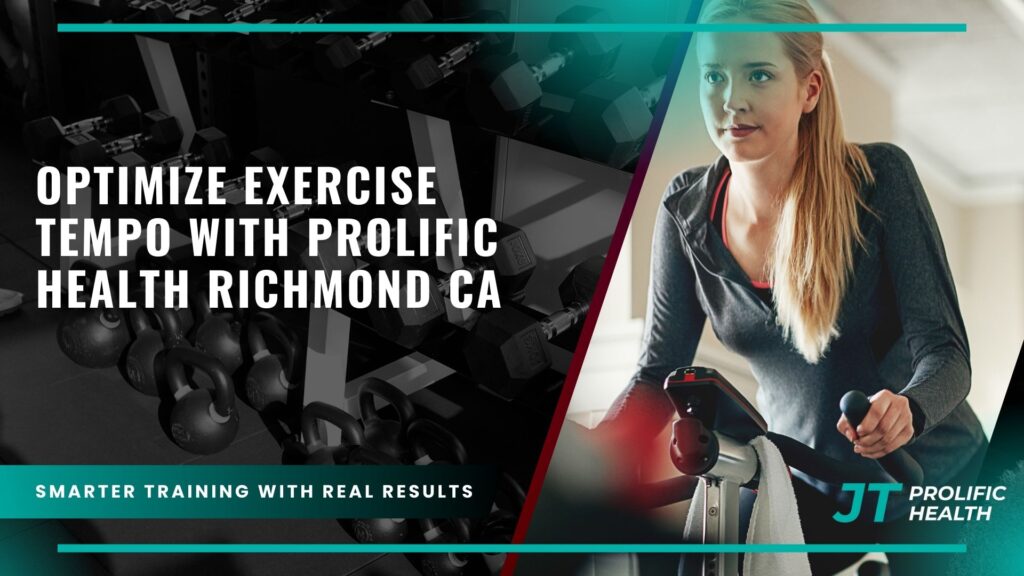Did you know slowing your lifts by just two seconds can increase muscle activation by 30%? At Prolific Health, with locations in Richmond and Vancouver, we’ve seen how precise movement timing transforms fitness outcomes. Our approach goes beyond counting reps—it’s about mastering the science of speed control.
Controlled training uses a simple 3-4 digit system to break movements into phases. Each number represents seconds spent lowering, pausing, lifting, or resting. This method isn’t about moving slower—it’s about working smarter. Strategic timing creates tension that sparks growth while protecting joints.
Whether you’re lifting weights or doing bodyweight drills, our Richmond-based team tailors tempo plans to your goals. You’ll learn why rushing through motions limits progress and how intentional pacing unlocks hidden potential. Proper rhythm turns ordinary workouts into precision tools for building strength safely.
Key Takeaways
- Movement speed directly impacts muscle engagement and results
- 3-4 digit codes simplify complex timing strategies
- Controlled phases reduce injury risks during workouts
- Personalized pacing adapts to individual fitness levels
- Scientific methods enhance traditional training approaches
Understanding Exercise Tempo
Have you ever considered how movement speed shapes your fitness results? At Prolific Health, we teach Richmond and Vancouver clients to view workouts as timed sequences rather than random motions. This precision transforms how your body responds to challenges.
Defining the Rhythm of Your Reps
Every repetition follows a hidden pattern. Think of it like music – rushing through notes creates noise, while measured pacing produces harmony. Our trainers help you find the beat that maximizes tension and minimizes strain through methods like private training.


Breaking Down the Number Code
Those mysterious 4-digit sequences hold specific meanings:
- First number: Lowering phase duration (3 = 3 seconds down)
- Second number: Pause at movement’s lowest point
- Third number: Lifting speed control
- Fourth number: Rest before next rep
This system lets our team craft personalized challenges. A 3010 sequence creates different effects than 1311 – we’ll show you why. Whether building strength or enhancing mobility, your numbers tell a biological story.
Clients in Richmond often discover their usual “fast reps” miss 40% of potential muscle engagement. Vancouver athletes learn how strategic pauses boost power generation. It’s not about moving slower – it’s about moving purposefully.
The Science Behind Tempo Training
Ever wondered why some lifters gain strength faster despite similar routines? Research reveals that precise movement timing triggers unique biological responses. At Prolific Health, our Richmond and Vancouver teams use evidence-based methods to turn this science into tangible results, whether in group strength sessions or individual coaching.


How Time Under Tension Fuels Muscle Growth
Your muscles respond to sustained effort, not just weight lifted. Extended tension during reps boosts muscle protein synthesis by 40% compared to rapid movements. This process creates microscopic tears that rebuild stronger tissue during recovery.
Studies show 4-second lowering phases increase growth hormone production by 23%. Our trainers use these findings to design programs balancing duration and intensity. You’ll experience how measured pacing activates more muscle fibers than traditional approaches.
Benefits of Controlled Eccentric and Concentric Phases
Lowering weights slowly (eccentric phase) leverages your muscles’ natural strength. Research confirms muscles handle 20-50% more load during descents. This controlled stress builds durability while protecting joints.
The lifting phase (concentric) benefits from strategic speed too. Accelerating through this motion develops power, while maintaining control prevents momentum from stealing gains. Our clients in British Columbia use this dual-phase focus to break through plateaus safely.
Key Tempo Number Sequences in Training
What if your workout routine had a secret code? At Prolific Health, we use tempo sequences to unlock hidden potential in every session. Each digit represents seconds spent in specific phases, turning random efforts into strategic growth opportunities.


Exploring Formats Such as 3010, 1311, and 2020
Our Richmond and Vancouver trainers craft programs using three core patterns:
- 3010 Code: 3-second lowering phase, no pause at the bottom, explosive lift upward. Targets power development while maintaining muscle tension.
- 1311 Sequence: 1-second descent with a 3-second hold at the lowest position. Builds strength where movements often break down.
- 2020 Rhythm: 2-second durations for both lowering and lifting phases. Creates stability for newcomers handling lighter weights.
The 3010 method develops explosive force without sacrificing control. Its quick upward push challenges fast-twitch muscle fibers. The 1311 format strengthens weak points through extended pauses at vulnerable positions.
Beginners benefit from 2020’s predictable pacing when learning proper form. Each sequence addresses different needs – whether pushing past plateaus or refining technique. Matching these codes to your goals creates measurable progress.
Master Your Exercise Tempo for Optimal Results
What separates good training from great results? Controlling movement speed transforms random efforts into calculated progress. At Prolific Health, we treat rhythm mastery as essential for clients in Richmond and Vancouver – like learning musical timing before playing symphonies.
Consistent pacing separates successful athletes from those stuck in plateaus. Our trainers help you count seconds precisely while coordinating breath and form. Imagine maintaining perfect technique even during final reps – that’s the discipline we cultivate.
Fatigue tempts many to rush through motions, sacrificing quality for quantity. We teach strategies to combat this instinct. You’ll learn to prioritize steady rhythm over speed, keeping tension where it matters most.
Mastered pacing enhances body awareness and training precision. Clients discover how intentional timing:
- Deepens muscle engagement during lifts
- Reduces compensatory movements
- Builds resilience against injuries
This skill signals true training maturity. Those who sustain proper cadence see better strength gains and joint health over years. It’s not just completing sets – it’s how you complete them that defines lasting success.
Applying Tempo Techniques to Weight Training
Could controlled movement phases be your key to safer muscle growth? At Prolific Health, we blend speed strategies with traditional weight programs across Richmond and Vancouver. This fusion creates adaptable plans that respect your current routine while boosting effectiveness.
Strategic pacing lets lighter loads deliver heavier results. A 3-second lowering phase with explosive lifts makes standard weights feel 20% more challenging. You maintain intensity without overloading joints – perfect for sustained progress.
Adjusting your approach requires simple tweaks. Reduce loads by 15-20% when first implementing timed sequences. This preserves energy for maintaining perfect form throughout extended tension periods. Our clients report better muscle activation within three sessions.
Breaking plateaus becomes achievable through varied rhythms. Alternate between 3010 sequences for power days and 2020 patterns for endurance focus. This approach stimulates different muscle fibers while keeping workouts fresh and engaging.
Controlled lifting sharpens technique across all major movements. You’ll develop cleaner patterns during squats, presses, and pulls. Improved movement quality translates to better performance in daily activities and athletic pursuits.
Prolific Health Approach to Tempo Training
Your fitness journey deserves a roadmap, not random guesses. Our Richmond and Vancouver teams use science-backed strategies to turn movement precision into measurable gains. We start by analyzing your current capabilities through three key lenses:
Every program begins with a movement quality assessment. Our trainers evaluate joint mobility, stability, and existing movement patterns. This foundation determines safe starting points for controlled reps.
Three pillars define our methodology:
- Personalized Progression: Begin with basic 2-second phases, advancing to complex sequences as skills develop
- Smart Combinations: Blend timed reps with resistance adjustments and recovery protocols
- Adaptive Monitoring: Adjust pacing weekly based on performance feedback
Advanced lifters benefit from tempo variations that challenge muscles without overloading joints. A 60-year-old client might use slower lowering phases to protect shoulders during presses. Young athletes could employ explosive lifts with controlled returns to build power safely.
Our evidence-based system helps you:
- Achieve strength milestones through strategic pacing
- Reduce injury risks via mindful movement control
- Break plateaus by alternating between speed-focused and stability-focused sessions
Clients across British Columbia experience transformative results by trusting the process. Whether rehabbing injuries or chasing personal bests, intentional timing becomes your secret weapon for sustainable progress.
Local Government Insights on Fitness and Safety Standards
British Columbia’s fitness regulations prioritize your safety through science-backed protocols. At Prolific Health, our Richmond and Vancouver facilities meet these standards by integrating controlled movement strategies into every session. This alignment ensures workouts build strength while minimizing risks.
Adhering to Provincial Health Guidelines
Provincial rules require trainers to emphasize proper form and supervised progressions. Our tempo-based methods naturally fulfill these requirements through structured rep phases. The 3-second lowering phase in many sequences matches guidelines for controlled eccentric movements.
Health authorities recommend extended pauses at vulnerable positions – like the “pause bottom” in squats or presses. These holds align with safety standards by reinforcing joint stability. Our trainers monitor these positions to prevent rushed transitions that strain tissues.
Utilising Local Data for Safe Practices
Vancouver Coastal Health reports 28% fewer gym injuries when facilities implement timed movement protocols. Our clients experience this firsthand through customized pacing that respects their current abilities. Slower rep phases create safer adaptation windows for new lifters.
Three key benefits emerge when combining regulations with rhythm-based training:
- Reduced momentum-related accidents through controlled speeds
- Better form retention via measured transitions between positions
- Progress tracking using objective time-based metrics
These practices demonstrate how smart pacing becomes your protective shield. Provincial guidelines and our methods share one goal – helping you grow stronger the right way.
Enhancing Strength Through Controlled Reps
True strength comes from control, not just heavy weights. At Prolific Health, we help clients build lasting power through measured repetitions. Rushed movements often miss critical development phases where muscles grow strongest.
Studies reveal matching time under tension creates equal strength gains whether using longer tempos or heavier loads. This means lighter weights with precise pacing can deliver similar results to max-effort lifts. Your nervous system adapts better to controlled challenges than erratic bursts of power.
Slower repetitions expose hidden weaknesses in your form. You’ll notice when certain muscles disengage or joints compensate. This awareness lets our trainers correct imbalances before they limit progress. Movement quality becomes your foundation for handling heavier weights later.
Three key advantages emerge with strategic pacing:
- Improved muscle coordination across full movement ranges
- Stronger stabilizer muscles protecting joints during lifts
- Enhanced mind-muscle connection for precise effort targeting
Clients discover controlled reps build strength evenly through every joint angle. This prevents “sticking points” where lifts often fail. When you eventually increase load, your body handles it safely thanks to this thorough preparation.
Customising Tempo for Different Exercises
Movement patterns demand unique timing strategies. Not all lifts follow the same rhythm – deadlifts and squats require distinct approaches. Our team creates tailored prescriptions matching each activity’s biomechanics and your personal goals.
Compound movements starting with upward phases need special attention. Pull-ups and deadlifts begin with concentric actions (lifting), while bench presses initiate with controlled lowering. We adjust codes accordingly:
- Deadlifts: 1-second pull, 2-second hold at top
- Squats: 3-second descent, 1-second pause in bottom position
Longer lowering phases benefit movements where control prevents injury. Explosive upward motions suit power development in Olympic lifts. Your strengths and weaknesses determine whether we emphasize speed or stability in specific phases.
Three factors guide our customization:
- Joint angles during peak tension points
- Equipment used (free weights vs machines)
- Recovery needs between sessions
As skills improve, we progress sequences from basic 2-second phases to advanced 4-digit codes. A beginner’s squat might use 2010 timing, evolving to 3111 as technique solidifies. This gradual approach builds competence while minimizing strain.
Your training evolves with you – smarter pacing creates lasting progress without compromising safety.
Integrating Tempo Training into Your Routine
Want better results without overhauling your entire workout plan? Start by adding timed phases to 1-2 movements per session. Focus on compound lifts like squats or presses where slower lowering phases (2-5 seconds) yield noticeable strength gains. This gradual approach prevents overwhelm while building rhythm awareness.
Pair timed reps with your existing weight selections. For example, use 3-second descents during bench presses before returning to standard-speed sets. Alternate tempo-focused days with dynamic sessions to balance muscle adaptation. Track progress by noting how controlled reps improve your power during explosive lifts.
Three seamless integration strategies:
- Apply 2-second lowering phases to warm-up sets
- Use tempo codes for accessory movements like rows or lunges
- Schedule dedicated tempo sessions every 7-10 days
Adjust pacing based on energy levels while maintaining core principles. Some days might allow crisp 20X0 sequences, while others benefit from deliberate 31X1 patterns. Consistency matters more than perfection – even partial implementation sparks progress.
Overcoming Common Tempo Training Mistakes
Mastering movement timing requires more than just counting seconds—it demands recognizing pitfalls that derail progress. Many lifters unknowingly sabotage results by prioritizing speed over precision. Let’s address two critical errors and how to fix them.
When Heavy Becomes Hazardous
Choosing weight that forces rushed reps defeats tempo training’s purpose. Your muscles need controlled tension, not momentum. Reduce loads by 15-20% to maintain proper pacing—this humility fuels long-term gains in strength and joint health.
Full Motion Matters
Shortened ranges occur when tempo challenges feel overwhelming. Maintain complete movement arcs even if it means using lighter weights. The “pause bottom” position in squats or presses reveals weaknesses to address, not avoid.
Three signs you’re compromising form:
- Bouncing out of the lowest position
- Inhaling sharply during lifting phases
- Losing count mid-set
Patience rewards those who respect the clock. Clients who embrace lighter weights with precise timing often surpass peers lifting heavier loads carelessly. Your future self will thank you for today’s disciplined reps.
Tempo Training for Beginners and Advanced Lifters
What if the secret to lifting smarter lies in matching speed to your skill level? At Prolific Health, we design distinct strategies for newcomers and seasoned lifters. Your experience determines how we structure timing patterns for maximum benefit.
New lifters build movement foundations through controlled pacing. Slowing reps to 3-4 seconds teaches proper joint alignment and muscle coordination. Light weights paired with deliberate timing create safer learning environments. This approach reduces injury risks while developing essential motor skills.
Experienced athletes use tempo variations to overcome plateaus. Advanced sequences like 40X0 (4-second lowering phases) challenge muscles differently than standard sets. These methods maintain progress without excessive joint strain. Strategic pauses at sticking points strengthen weak positions during lifts.
Three progression stages ensure safe advancement:
- Master 2-second phases with bodyweight movements
- Add external resistance while maintaining rhythm
- Incorporate complex 4-digit codes for targeted adaptations
Beginners often see faster technique improvements through timed reps. Veterans appreciate how varied pacing preserves joint health during heavy cycles. Both approaches share one truth – smart speed control creates lasting results.
Expert Tips from Prolific Health in Richmond and Vancouver CA
What separates effective training from transformative results? Our Richmond and Vancouver teams refine strength development through precision pacing. Consistent timing matters as much as your chosen weight – rushed reps sacrifice growth potential while controlled lifts maximize muscle engagement.
- Sync breathing patterns with movement phases (inhale during lowering, exhale when lifting)
- Use metronome apps to audit rep speed accuracy
- Alternate between explosive and slow-motion sets weekly
High-intensity sessions demand smart adaptations. Reduce loads by 10-15% when combining tempo work with increased reps. This preserves form integrity while extending time under tension. Our clients pair 31X1 sequences with shorter rest periods to boost endurance without compromising technique.
Plateau breakthroughs start with reassessing your numbers. If progress stalls, modify one digit in your tempo code every 3 weeks. A simple shift from 3010 to 3110 creates new stimulus patterns. Track how these adjustments affect strength gains and recovery needs.
Balance remains crucial. Blend timed lifts with dynamic movements like sled pushes or kettlebell swings. This hybrid training approach prevents overuse injuries while developing well-rounded athleticism. Remember – smart training evolves with your capabilities through measured adjustments.
Conclusion
Controlled movement timing revolutionizes how your body builds strength and endurance. By focusing on precise rep phases, you create optimal conditions for muscle engagement while protecting joints from strain. This method transforms ordinary workouts into strategic sessions that deliver measurable progress.
Prolific Health’s approach combines scientific principles with personalized guidance. Our Richmond and Vancouver teams tailor tempo strategies to your unique goals, whether you’re breaking plateaus or starting your fitness journey. The right rhythm enhances results without compromising safety through both in-person coaching and online coaching.
Ready to experience the difference? Call 604 818 6123 today or contact us. Let’s craft a training plan that aligns with your aspirations and unlocks lasting gains through intelligent movement control.




